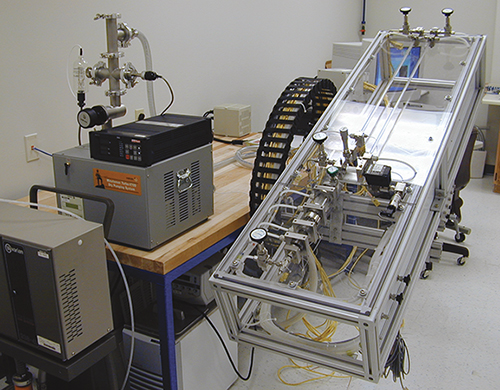
Micro Machining Enhances Precision Fabrication
Originating Technology/NASA Contribution
In President Ronald Reagan’s 1984 State of the Union address, he announced plans for a U.S. space station, the equivalent of the Russian space station, Mir. This announcement set off a flurry of congressional funding debates, and it was not until 1988 that the President announced that a consensus had been reached and the project would go forward. The project was named “Space Station Freedom.”
It was to be a permanently manned, Earth-orbiting outpost that could serve as a repair shop for the shuttle fleet, a microgravity laboratory, an observation point for astronomers, and an assembly station for spacecraft heading even farther into space. The project came to an end, unrealized, in 1990, when it was revealed that the design was over budget, overweight, and had been so complicated and compromised by the political debates and budget restrictions that it could no longer be realized.
Although Freedom never made it past the design stages, the science, and many aspects of the original designs, made their way onto the International Space Station (ISS), whose first component was launched in 1998. For instance, several advanced thermal systems developed for cooling everything from battery components to crew cabins originally designed for Space Station Freedom are still in use on the ISS.
These thermal systems, while more advanced and specialized than most used on Earth, like many terrestrial refrigerators, employ evaporative ammonia as their coolant. To create this simple refrigerant, heat is applied to a mixture of water and ammonia until the solution reaches the boiling point of the ammonia. The boiling solution then flows to another chamber, where the ammonia gas separates from the water. The gas floats upwards to a condenser, where a series of fins and coils cool it, allowing it to condense back into a liquid. The liquid ammonia then flows to an evaporator, where it is mixed with hydrogen gas, and, when it evaporates, produces cold temperatures. Having fulfilled its refrigerating purposes, the ammonia, along with the hydrogen, mixes again with the water. This solution releases the hydrogen gas, where it returns to await the ammonia gas, as the cycle continues.
Even though this same series of chemical reactions is used in space-bound refrigerators as in terrestrial versions, the space-bound coolers must have one major difference: they must be significantly smaller. Refrigerators are notoriously heavy, and weight is always a payload concern for space-bound equipment, so the Space Agency needed to engineer smarter, more efficient thermal systems.
Partnership
In the 1980s, through two Small Business Innovation Research (SBIR) contracts with Johnson Space Center, Dr. Javier Valenzuela worked on a project to develop an ammonia evaporator for thermal management systems aboard Freedom. At the time, he was serving as the principal investigator for these contracts while working with Creare Inc., of Hanover, New Hampshire.
In 1991, Valenzuela formed Mikros Technologies Inc., based in Claremont, New Hampshire, to commercialize the work he had done under the NASA contracts. In 2001, the company was awarded two SBIR research contracts from Goddard Space Flight Center and is, to this day, actively engaged in advancing micro-fabrication and high-performance thermal management technologies.
Product Outcome
The technique Valenzuela developed was an advanced form of micro-electrical discharge machining (micro-EDM) to make tiny holes in the ammonia evaporator. The evaporator relied on droplet impingement cooling to achieve high heat flux and low thermal resistance. Many thousands of small nozzles were required to “print” a thin layer of ammonia over the surface of the evaporator. However, no technology existed at that time for the fabrication of suitably shaped micro-nozzles in metals. Mikros’ micro-EDM technology was developed to meet this need. Micro-EDM is an erosion process, in which electrical discharges between two electrodes (one on the tool, and the other on the conductive work surface) machine very small holes, channels, and cavities.
Micro-EDM can cut complex shapes into a variety of conductive materials, regardless of the material’s hardness, even hard materials such as steels and carbides. It can also be used on materials like ferrites and silicon, which have the tendency to crack or become brittle when exposed to traditional (macro) EDM.
All EDM has the additional advantage of noncontact machining. The method, which relies on a gap between the tool and work surface for the discharging of the spark, allows the process to take place with no pressure being placed on the material. This means that micro-EDM can be used on very thin and very fragile surfaces, and even on curved surfaces, without damaging them.
Mikros has had great success applying this method to the fabrication of micro-nozzle array systems for industrial ink jet printing systems. The company is currently the world leader in fabrication of stainless steel micro-nozzles for this market. It routinely fabricates nozzle arrays with hundreds or even thousands of shaped nozzles with diameters ranging from 30 to 80 microns. The micro-nozzle arrays are machined in thin, free-standing foils, or on foils that are diffusion bonded to thicker substrates with complex internal flow passages.
The company has continued its relationship with the Space Agency, too. Its other division, in addition to micro-EDM, is thermal systems, which is currently still involved with Goddard through the SBIR contracts to develop a high-heat flux capillary evaporator for use in loop heat pipes or capillary pumped loops.

Breadboard and test station of Mikros’ High-Heat Flux Evaporator for the Phase II NASA SBIR project.

Artist’s concept of the Space Station Freedom, a design that led to many of the technologies currently aboard the International Space Station.













